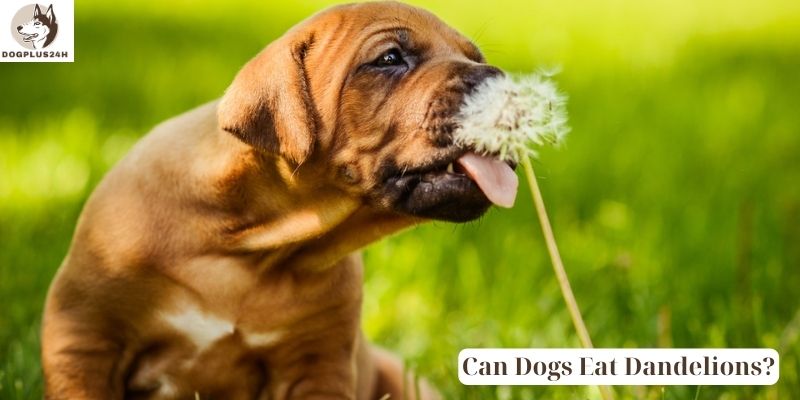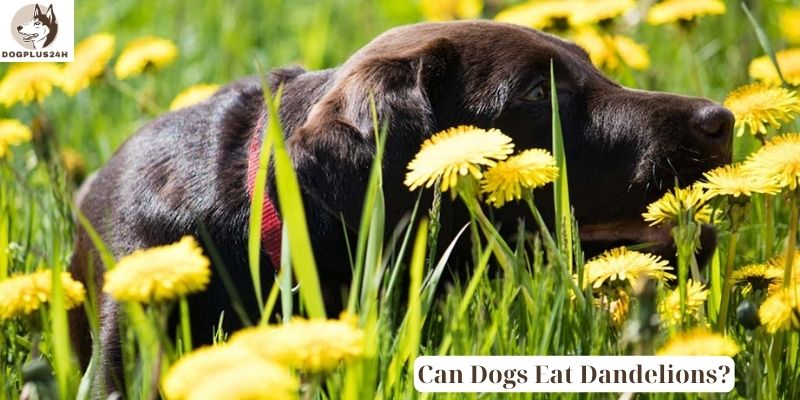Can Dogs Eat Dandelions? The weed you despise but love is the dandelion. Another plant with a big list of advantages that you can’t ignore is this one. It functions as an antibacterial, digestive aid, and liver tonic. Even the better control of diabetics has been connected to it. You should anticipate having your lawns pave with dandelion gold with traits like these. Can Dogs Eat Dandelions, though? Continue reading with Dogplus24h.com to learn more:
What is a Dandelion?
The scientific name for dandelions is Taraxacum officinale, and they belong to the sunflower family of plants. Dandelions are a type of perennial flower that can reach heights of almost a foot! The stem and leaf components of the dandelion plant are what make up the dandelion greens (or what we’re worried about!). Because of their tenacity and propensity to take over a lawn or garden, these plants are frequently regarded as weeds. The 20th century is the only time that this categorization has been in use.
Priest’s crown, lion’s tooth, witch’s gowan, swine’s snout, milk witch, and blowball are some of the common names for the plant. Various dandelion species can be found in North America, Europe, and Asia. They are among the most widespread plants on the earth.
Can Dogs Eat Dandelions?
 Not only are dandelion greens healthy for your dog, but they also make a fantastic addition to dog food. Dandelion greens contain protein, crucial minerals including calcium, potassium, iron, zinc, and manganese, as well as vitamins A, C, K, D, and B in their natural state. Dandelion greens have three times as much calcium, three times as much iron, fifteen times as much vitamin A, and three times as much vitamin E as broccoli.
Not only are dandelion greens healthy for your dog, but they also make a fantastic addition to dog food. Dandelion greens contain protein, crucial minerals including calcium, potassium, iron, zinc, and manganese, as well as vitamins A, C, K, D, and B in their natural state. Dandelion greens have three times as much calcium, three times as much iron, fifteen times as much vitamin A, and three times as much vitamin E as broccoli.
Dandelions also assist optimum digestion and waste disposal because they are a modest liver and digestive stimulant. In essence, dandelions are the best of the best, not a hated weed!
Different civilizations have long believed that dandelions, a widely accessible herb, had medicinal qualities. Some herbalists still refer to dandelions as the “perfect plant medicine.” Dandelion tea was a popular remedy among Native Americans in North America for kidney disease, inflammation, heartburn, stomach difficulties, and skin disorders. Greens from dandelion plants were used to treat diabetes, diarrhea, and fevers in Europe. Dandelions were utilized in Chinese medicine to cure appendicitis and other digestive problems. Dandelions are used as a mild diuretic by modern herbalists to promote urine production and cleanse the liver and kidneys.
Additionally having medical benefits, dandelion greens have been used as a digestive aid, a mild diuretic, and to enhance liver function. They are also thought to possess anti-inflammatory qualities.
What Part of Dandelion Plant Can Dogs Eat?

Dandelions are edible and safe for dogs to eat, however different portions of the plant have different nutritional values. Here are three areas of dandelions that are particularly rich in nutrients:
- Flower: Dogs can eat dandelions’ yellow blossoms as well as their seed puffs: Antioxidants and polyphenols are abundant in dandelion blossoms. These vitamins and minerals may help your dog’s body fight off free radicals and strengthen its immune system.
- Leaves: The most nutrient-dense parts of the plant are the leaves and the dandelion greens. To increase the nutritional content of your dog’s regular kibble diet, you can add these greens to their meals.
- Roots: To help your pet’s liver function, use dandelion root extract as a natural liver tonic. Additionally, dandelion roots offer anti-inflammatory qualities that can speed up your pet’s muscular recuperation and lessen joint pain.
When Should You Pick Dandelion?
If you’re fortunate, dandelions that bloom in the spring may blossom once more in the autumn. Do not be confused with other sunflower family members. The single taproot of the dandelion grows in rosettes directly into the earth.
Although dandelion pesticides are harmful, dandelion pesticides themselves are not. Therefore, avoid collecting them from public locations where weeds have surely been sprayed. Choose them instead from your own yard.
Early in the spring, before the flowers blossom, gather leaves. The leaves then start to taste harsh. After gathering your leaves, let them dry before bagging them for later use. Or, to avoid having to purchase them during the off-season, loosely freeze them when they are still fresh. They can also be chopped up and dried in the sun.
Use the flowers in the same way. Pick, then loosely or dry freeze. Wait until late October if you’re utilizing dandelion root for dogs. Cut them up after you dig them up. Then, spread them out to dry on some newspaper.
Three advantages of dandelion for canines’ health
Think about the following health advantages your dog can get from consuming real dandelion blossoms on occasion:
1. Improved immune system:
Vitamin A and various B-complex vitamins found in dandelions can aid your pet’s immune system and energy levels. This could aid in protecting your dog from illnesses and infections.
2. Better digestion:
Dandelion includes inulin, a probiotic that can improve the health of your dog’s digestive system and boost the amount of beneficial bacteria there. To help your pet’s digestion, add a few drops of dandelion tincture to each serving of dog food. An extract of dandelion can help your dog’s gallbladder function, act as a laxative to treat indigestion and maintain body weight. Dandelion, a natural diuretic, can lessen your dog’s risk of putting on weight and developing the numerous health issues associated with obesity.
3. Strong bones and teeth:
Your dog’s body uses calcium and the vital minerals potassium and manganese to produce strong bones and teeth.
The 3 Dandelion Health Risks for Dogs

Although dandelions are typically a low-risk, high-reward treat for your dog, there are some possible negative consequences you should take into account before letting your dog consume dandelions. Just a few health dangers to be aware of are listed below:
1. Constipation:
Although dandelion is generally a harmless diuretic, giving your pet too many dandelion greens might make digestion difficult. The digestive tract of your dog may become blocked by an abundance of organic debris. Your pet may experience potentially fatal gastrointestinal issues if this obstruction causes constipation. To avoid these problems, give your dog modest, irregular amounts of dandelions.
2. Digestive problems:
Although most dogs are safe with fresh dandelions, it’s always conceivable that your dog could have a negative reaction to a new meal. Keep an eye out for symptoms of food intolerance or allergies in your dog, such as indigestion, heartburn, vomiting, and diarrhea.
3. Poisoning:
Although dandelion plants themselves are not dangerous to dogs, frequent exposure to synthetic pesticides and herbicides can make dandelion plants hazardous to canines. Do thorough research on the source of any dandelion supplements or dandelions you want to consume, and stay away from any that you suspect may have hazardous residues present.
Uses For Dandelion
Dandelion roots, leaves, or blossoms can be used. They can be consumed fresh, dried, or in tea or tonic form.
- Fresh leaves: If you feed your dog dandelion, supplement his meal as necessary with blooms or a few ripped leaves. For tiny dogs, one or two leaves; for larger dogs, more. Alternatively, you might puree some leaves with some water and add them to his lunch.
- Dried roots or leaves: Sprinkle dried herbs on your dog’s food. 1 tsp is required for every 20 pounds of body weight.
- Bitter tonic: You should give your dog some before dinner because it will aid with digestion. To encourage your dog to drink, blend some leaves with some broth. You can simply add a teaspoon or two to his food if that doesn’t help.
- Rooibos tea: Use 8 oz. of water and 5g to 30g of dried herb (leaves, roots, or blossoms) to steep for 10 to 15 minutes. For every 20 pounds of your dog’s body weight, you can use 1/3 of a cup of tea, up to three times each day.
How much dandelion can dogs eat?
There aren’t any specific restrictions on how much dandelion dogs can consume, so if your pet likes to chow down on grass and other vegetation, they might eat a lot of it! Eating excessive amounts of dandelion can upset your stomach, just like eating excessive amounts of any other plant or vegetable.
Your veterinarian can advise you on the right dosage for your dog and whether using dandelion as an herbal medicine is safe for their particular needs. (Especially if they are also taking any other prescription drugs!) Depending on the product you’re using, the safe dosage for pills, tinctures, and dried herbs will differ, and the dosage must be determined in accordance with your pup’s weight.
A dog shouldn’t consume more than one drop of tincture per kilogram of body weight as a general guideline. For instance, a 20 kg dog should only receive 10 drops daily.
Dogs are only allowed one teaspoon per 10 kilos of body weight per day of dried leaves since they are more potent than fresh leaves. In other words, if your dog weighs less than 5 kg, they should only consume a half-teaspoon of dandelion leaves daily.
How to Handle a Dog Who Constantly Eats Dandelion?
Handley advises keeping dandelions away from your dog (you can use one of these gates) or training your dog a command to divert his attention to something else if he can’t get enough of them and keeps suffering an upset stomach.
Apply a pet-safe weed killer to prevent your dog and other outdoor animals from becoming poisoned if you’d prefer to completely remove dandelions from your yard.


